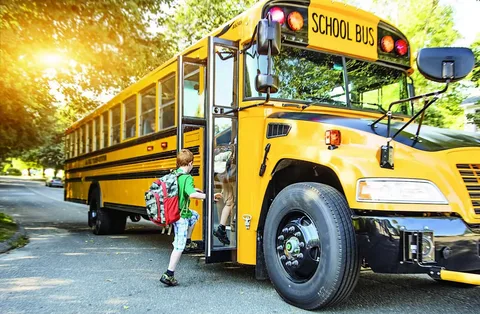Railroad Crossings and YOU!

Please allow me to begin this page in simply saying that I see otherwise excellent drivers rolling past railroad tracks in their buses quite often. Not only is this practice unsafe and against the law in ALL 50 states, It can be deadly. Don’t believe it? Watch this short video…If it seems like I’m a bit angered here, I’m not, but this is real…
Can you imagine if the bus was loaded with students? IF you survived, could you live with yourself? You don’t want this to be YOUR bus!

This tragic accident occured in Fox River Grove, Illinois. The school bus–train collision was a grade crossing accident that killed seven students riding aboard a school bus on the morning of October 25, 1995. The school bus, driven by a substitute driver, was stopped at a traffic light with the rearmost portion extending onto a portion of the railroad tracks when it was struck by a Metra commuter train on its way to Chicago.
Each year, approximately 4,000 train/vehicle collisions occur at railroad crossings. These 4,000 collisions result in about 400 fatalities and 1,100 injuries. Unfortunately, some of the crashes involve school buses that result in injuries and fatalities to students. In an effort to avert these crashes, the following procedures are recommended to all school bus drivers. It is important to note that these recommendations must be considered within the context of individual state laws and regulations. As usual, these are recommended, however, follow the law in your state or province.
- When making stops for railroad crossings, carefully observe all traffic. Use school bus hazard warning lights, and tap the brakes to communicate to traffic that the bus is about to stop. Take these actions far enough in advance to avoid startling motorists behind the bus, which could possibly cause panic stops or rear-end collisions.
2. Bring the bus to a full and complete stop, apply the parking brake, and place bus in neutral. Stop the bus within not less than 15 feet or more than 50 feet from the rails nearest the front of the bus. This applies for crossing any track, whether or not the bus is carrying passengers.
3. After stopping the bus, fully open the service door and the driver’s side window, turn off all noisy equipment (radios, fans, etc.), instruct students to be quiet, and look and listen in both directions along the track or tracks for approaching trains. In instances where school bus loading/unloading red warning lamps are activated by opening the service door, deactivate such lamps by using the master control switch.
4. If the view of the railroad track or tracks is not adequate, do not attempt to cross the tracks until you can see that no train is approaching.
5. If a train passes from one direction, make sure that another train, possibly hidden by the first train, is not approaching on an adjacent track.
6. For railroad crossings equipped with warning devices such as lights, bells, and/or gates, always obey the signals. Never ignore railroad crossing signals. If a police officer or flagman is present at the crossing, obey their directions, but be sure to make your own visual check.
7. Before crossing the tracks, ensure there is adequate room on the other side of the tracks and train right-of-way for the entire bus. It is always possible that the bus may have to stop immediately after crossing the railroad tracks.
8. When the tracks are clear, completely close the bus service entry door and place the transmission in a gear that will not require changing gears while crossing the tracks. In instances where school bus loading/unloading red warning lamps are activated by opening the service door, and such lamps were deactivated by using the master control switch, reactivate the school bus loading/unloading lamps. Leave all noisy equipment turned off, and continue looking in all directions as the bus crosses the tracks. After safely crossing the tracks, turn off the hazard warning lamp.
9. If the bus stalls while crossing the tracks, evacuate the students and move them a safe distance away from the bus as quickly as possible. If a radio or telephone is available, notify the school bus dispatcher of the situation. If a train is approaching, have everyone walk in the direction of the train at a 45 degree angle away from the train tracks.
10. Weather conditions, such as fog, snow, rain, and wind, can affect the driver’s ability to see and hear an approaching train and to determine the safety of crossing railroad tracks. Additional caution must be exercised during such conditions.
11. Report malfunctioning railroad signals or hazardous railroad crossing conditions to the appropriate school transportation personnel.
Multi-Track Crossings
At crossings with more than one set of tracks, do the following…
1. Check the crossbuck for a sign indicating the number of tracks at the crossing.
2. Make sure no train is approaching on any of the tracks
3. Only make one stop – not one stop per track.
4. After a train passes, wait until other tracks become visible before proceeding. A second train may be
approaching from the opposite direction.
Here’s some statistics for you to think about…
There have been at least 166 train-school bus collisions known to have occured between 1902 and 2000, the last in Conasauga, Tenn., when a freight train traveling at 51 mph struck the passenger side of a Murray County, Ga., School District bus that was crossing the railgrade. Another major crash occurred several years earlier in Fox River Grove, Ill.
Here’s a few more videos to watch…
In this first one, and man filming trains gets more than he bargained for…
Here is a excerpt of a driver blowing through GATES
And last, The opening to the movie “Atomic Train” Look at these kids faces, and imagine it in real life…
Crossing “Signs of Life”
Public highway-rail grade crossings have been marked with one or more of the following warning devices for your safety by both state highway departments and the railroad companies. Learn what they are and watch for them. With these warning devices, and caution on your part, highway- rail grade crossing crashes should never happen.
 |
Advance Warning Signs Advance warning signs mean a highway-rail grade crossing is ahead and are located at sufficient distance to allow you to stop (if necessary) before reaching the crossing. |
 |
Pavement Markings Pavement markings, consisting of a R X R and stop line, may be painted on the pavement in front of the crossing. Always stay behind the painted stop line while waiting for a passenger train. |
 |
Railroad Crossbuck Signs
|
 |
Flashing Light Signals
|
 |
Exempt Sign
The EXEMPT crossing sign placed below the crossbuck informs drivers of school buses carrying children that a stop is not required.
|
 |
Tracks Out Of Service The TRACKS OUT OF SERVICE sign tells the driver trains no longer travel these tracks. It is not necessary to stop at these crossings. |
 |
Track Number This sign indicates to the driver how many tracks there are at this crossing. In this case, there would be 3. Never assume that if a train just clears one track, that it is safe for you to go. You still must follow procedure, as there may possibly be a second train on one of the other tracks! |
 |
Low Gound Clearance This sign means that the tracks have lower than normal ground clearance. If you go over a set of these, make sure that you will not get stuck on the tracks. |
 |
Parallel Track The yellow diamond PARALLEL TRACK sign identifies highway-rail grade crossings that appear immediately after making either a right or a left turn. |
 |
Gates Gates are used with flashing light signals at certain crossings. Stop when the lights begin to flash and before the gate begins to lower across your road lane. Do not attempt to cross before the gates are raised and the lights have stopped flashing
|
Thanks so much for taking the time to learn about railroad crossing safety.











